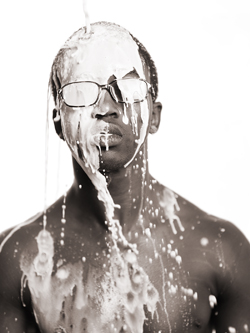It’s an Image of Sex. It’s Not about AIDS
The Legacy of the AIDS Crisis on American Art (It’s Never Not about HIV)
“AIDS? Wasn’t that an art movement in the eighties?” quipped the young Chelsea gallerist, straining for just the right mix of irony and hipness. Sensing that her question missed the mark, the young woman then quickly offered, “Well, that’s a joke I often hear from artist friends when they talk about AIDS.” Her remarks betrayed a too-often-repeated distancing strategy from the reality of HIV/AIDS and the underlying complexity that the epidemic poses for artists today. On one hand, such comments hint at the wholesale incorporation of AIDS-themed art practice into the academy/marketplace. At the same time, they actively repress the urgency and omnipresence of HIV in the lives of artists today. Simply stated, if HIV did not pose an immediate and constant threat, there would be little reason to joke about it. To dust off one of the trusty slogans once again: The AIDS crisis is not over. And its trace may be found in much contemporary art.



There is a fundamental mischaracterization about the relationship between the AIDS crisis and contemporary art. In general terms, art about HIV or the AIDS crisis is generally understood as didactic, delimited, historical, and finite. This work has been categorized solely as a powerful response to a past crisis, one that tapered off sometime in the mid-1990s. In this paradigm, art about the AIDS crisis divides into two types of responses (as evidenced by selective titles), either agitprop by collaborative groups like Gran Fury (“With 42,000 Dead, Art Is Not Enough”) or emotionally charged gestures or memento mori by artists such as Nan Goldin (Gilles in Paris), Felix Gonzalez-Torres (Perfect Lovers), Bill Jacobson (Interim Portraits), and David Wojnarowicz (Hujar Dead), among many others. In both characterizations, artists returned to the fundamental and traditional abilities of art to convey deeply held beliefs and visceral emotions. The striking difference about this work compared to other art of its time is the critical importance of how the artists directly shared their personal experiences with the viewers. These artists fundamentally altered the course of American art, and consequently their works have entered the canon of American art history.
In the mid-1990s, AIDS seemingly disappeared from American streets and retreated into the recesses of America’s cultural consciousness: the election of Bill Clinton in 1992 realigned the realpolitik; the availability of effective antiviral treatments (the “cocktail”) transformed the infection into a “manageable, long-term illness” rather than an immediate death sentence; and AIDS activists reached a point of intellectual and spiritual exhaustion. There was an impression that the crisis was nearing its end, and the production of images in service of the AIDS crisis decreased rapidly.
Despite the wishful belief in the disappearance of AIDS, the artistic practices adapted from the precedents of the late 1980s and early 1990s continue to inform recent artists, who seek to reflect the complexities of contemporary society and add their aesthetic imprimatur on an era. An informed and careful reading of such recent art reveals the profound persistence of HIV/AIDS in the visual arts. Although the overt thematization of HIV/AIDS is practically disavowed by artists, institutions, and galleries today, one must wonder why certain younger artists have returned to an exploration of sexual content and what it says about their relationship to HIV/AIDS.
To be certain, artists continue to engage with the changing epidemic through a spectrum of responses ranging from direct address to heavily camouflaged personal expression. Like the earlier generation, these artists create imagery to voice their political agendas or personal insecurities instilled by circumstance, which is defined in no small part by HIV/AIDS. It is simply a matter of choosing to acknowledge its presence. Any reading of their work without consideration of HIV/AIDS would be inadequate as it would ignore the cultural context in which the artwork came into existence and diminish the personal experience of the artists. These artists grew up in the age of “safe sex” and are confronted by the presence of HIV in every intimate encounter, every personal relationship. They never knew a world without HIV.
Thus, the persistence of HIV/AIDS as a significant cultural force must be acknowledged. Without awareness of the potential impact of HIV on the artists, engaging with such works feels less rich and multivalent. The art becomes less poetic in its import and weakened in its agency. It loses the potential for meaningful personal and social exchange, and its sharpness as an indicator of contemporary society is blunted. Ignoring the impact enables the ongoing repression of AIDS within American culture.
Examining this art through the lens of HIV/AIDS is a subtle endeavor indeed. There are few visual signs of the ongoing American epidemic. AIDS-related wasting, Kaposi’s sarcoma, or diseases that impart telltale signs of the retrovirus have been eradicated by antiviral medicines. Political imperatives to address the epidemic have been refocused outside the American political arena onto foreign countries, where the crisis is severe, growing, and visually present. There are no longer massive political demonstrations, only bland public meetings over obscure and convoluted disputes regarding AIDS policy agenda. But HIV/AIDS remains present, particularly in the MSM (men who have sex with men) and gay communities across the United States.
Artists leave the door open to consideration of HIV in their work, but it is usually through idiosyncratic and typically oblique approaches. They have absorbed the lessons from art school and mastered the practice of the artists from the first generation of the AIDS crisis. Their knowledge of how to construct an image comes from the hard-learned lessons of their predecessors. In recent work, artists avoid bringing the virus or its impact into visual register. Instead of direct address, they lead with the frank depictions of sex that do not deny the deeply entrenched position of HIV as a social phenomenon or personal condition. The recent images, usually sexually active and radical in their bold honesty, speak to the day-to-day navigation of HIV in American culture.
Dean Sameshima, a Los Angeles- and Berlin-based photographer, riffed on an untitled billboard project of an image of an unmade bed with two pillows left with indentations by Felix Gonzalez-Torres. Sameshima’s In Between Days (Without You) (1998), a series of ten unmade beds with similarly indented pillows, upends the sense of helplessness and loss that informs the billboard beds of Gonzalez-Torres. Sameshima made his photographs in the sex clubs of Los Angeles after a series of anonymous sexual encounters. They serve as a trophy of conquest and a record of survival. These images are meant to challenge the hopelessness of the billboard project while reclaiming the sense of sexual freedom that was part and parcel of gay culture before AIDS. Sameshima demands a return to “lost” freedom and uses an iconic AIDS image to declare his intent to exist freely in a “post-AIDS” world.
Marcelino Gonçalves makes gay sensuality and sensibility central to his work, including Boys (2005). This image plays on the fantasy of an all-male summer camp, as fourteen young men cluster in a swimming pool. Two young men hold the center of the composition, one languidly embracing the other from behind. There is no psychological tension suggesting a hazing ritual, only a charged atmosphere of shirtless young men vying for each other’s attention. Gonçalves brings us into the world of boundless, adolescent sexual friction.
Gonçalves’s unifying aesthetic and themes define him squarely as “queer.” His images resist the mainstream ideals or norms and are motivated by his personal responses to mainstream heteronormalizing tendencies. The interesting aspect about Gonçalves’s paintings is not that they depict same-sex desire but that they do so in a full and rich context. For example, Boys is not a fantasy about a lost summer camp experience but an articulation of the richness and persistence of desire. For Gonçalves, the evocation of a complete set of associations about his experience of being gay is central to his paintings. One of many of these associations is ongoing awareness of HIV. Looking at Boys, one has to examine it through the filters of HIV and its impact on the sexual behavior of young men. To ignore or avoid this reality fosters the insidious spread of the epidemic.
The Seattle photographer Steven Miller frames his response to HIV no less ambiguously but more personally with his series Milky (2006). Working with a group of friends, colleagues, and acquaintances, Miller stripped his subjects and poured copious amounts of milk over them. Some sitters expressively respond with delight or surprise, others stoically endure their circumstances. Miller deliberately chose milk, constructing a metaphor for semen and portraying young men who must navigate the perils and delights of the white substance. Miller’s Milky portraits offer an array of responses to the possibility of HIV. The formal qualities of the photographs, the white milk, and the white background suggest the ubiquity of awareness of HIV.
New York–based video artist Kalup Linzy’s Lollypop (2006) foregrounds sexual banter in the sterile confines of the institution. Linzy and artist Shaun Leonardo lip-synch to the 1933 Hunter and Jenkins tune in a florid display of performativity and sexual innuendo. Echoing across the decades, Linzy recasts the sexual negotiation within the contemporary context of masculine identity in African American communities and the stereotypes of queerness of Black gay men.
Although HIV is never broached in Lollypop (how could it be with the lyrics prescribed by a 1933 pop tune?), it seems ingenuous and naive to insist that Linzy and his collaborator remain untouched by or unconcerned with HIV/AIDS. This is not to say that Lollypop is in any way a direct response to HIV. Yet, without acknowledging the influence of HIV on the video, it permits an avoidance or the silencing of the reality of Linzy, his cohort, and our culture. Although the playful metaphor of sharing candy leads to the negotiations of an intimate relationship, today young men and women must simultaneously weigh the risk of HIV. The sexual banter enacted by Linzy and Leonardo speaks not only to the quest for sexual pleasures but also to the constant navigation of the multifaceted complexities of sexual exchange and the implications of HIV.
Derek Jackson places sexual expression in the center of his Perfect Kiss (2007). As the work, the artist performs a variety of sexual encounters (two scenes of public sex in a park, the connections via social media and the Internet, and a hookup in his home) interspersed with images of the shirtless artist dancing. Using what the artist euphemistically labels “found sound,” Jackson appropriates as his soundtrack the melancholy “Perfect Kiss” by New Order, a 1985 pop lamentation about a friend’s suicide. Through his series of sexual encounters, does Jackson equate the risk of HIV infection with suicide by a handgun?
The startling feature of Jackson’s Perfect Kiss is not the graphic simulation of gay sex but the unexpected and penetrating intensity of the artist’s direct gaze, which implicates the viewer not only in the sexual exchange but also the honest disclosure of serostatus. Using the repeating refrain “I know, you know, we believe in a land of love” intermingled with his piercing stare, the artist compartmentalizes safe sex or HIV awareness. They swiftly become theoretical constructs overwhelmed by desire and pleasure. Pondering the implications of Perfect Kiss, the viewer is left to grapple with his or her own willingness or ability to disclose and request that information from Jackson (or, metaphorically, their own partners) while first and foremost working through the differences between sex and love.
In his 2006 film v. o., William E. Jones explores the spaces between sexual encounters. Jones revels in the exotic: the glamour of European languages and films and the lost glories of sex before AIDS. Named after the French film term version originale for films screened in their original language with subtitles, Jones spins his own narrative arc, splicing together nonsexual “linking” scenes from pre-AIDS gay pornography made before 1985. To accompany the footage, Jones adds a montage of sound culled from classic foreign films and provides English subtitles such as “Did love for you begin with a boy” and “Live, to explain to the world with your loyalty to the shadow, the reason you led me to this chasm.” Although tinged with yearning for a time and a sexual culture before AIDS, v. o. lays bare the universal and timeless qualities of desire and the search for love. The power of Jones’s work comes from resonance between the romanticized memories and the meaning that such images have today. We are constantly reminded of the consequences of HIV/AIDS — all the players in the film’s segments have a freedom that Jones and we do not. As such, the film serves not as an elegy to a decimated generation or homage to a cinematic genre but as a poignant reminder that the potential for pain and loss informs our every response to such rudimentary desires.
John Arsenault’s unapologetic presentation of gay sexuality evokes the imagery and intent of the earlier generation of artists such as Robert Mapplethorpe and Peter Hujar. Arsenault also reflects the rapid and dramatic societal changes of the last two decades with an audacious freedom and strikingly refined aesthetic. Many of Arsenault’s images self-consciously include the shutter release and the cord, connecting the photograph to the object of its creation. In There Never Was a Woman of My Dreams (2010), he strokes his partner’s neck, thus making a double portrait focusing on a moment of unrestrained sexual contact as much as on their likenesses. Grounding his image in the social and political dialogues surrounding marriage equality, Arsenault’s self-portraits speak to a social reality that codifies the advances of the GLBT community. Arsenault demands attention be paid to active, healthy, and pleasurable gay sexual practices. In essence, he demands recognition of his sexual freedom. Such freedoms require the partners to respect and understand each other’s relationship to HIV — however complicated and varied it might be.
Reading or interpreting artworks in this manner risks straining the artists’ intent. None of the artists discussed previously would consider their practice to be “about HIV/AIDS.” But none of them would deny the impact of HIV on their personal lives. Like many from the “post-AIDS” generations, HIV is a fundamental part of their experience as humans. It no longer demands their full and immediate attention, but it does keep them grounded.
Such a broad understanding of the works by Arsenault, Jackson, and other artists requires that the cultural context of the works’ production be brought to the foreground. It also involves activating the tension between two almost opposing philosophical approaches to looking at art. The first is an archaic position that underscores the universality and moral role of art in society. This approach, which traces its lineage to the Enlightenment-age philosophical tracts of Immanuel Kant, posits that art must be an authentic expression and fundamentally reflect contemporary conditions. The artist functions as the primary arbiter of her or his era’s “universal truth” or “moralities.” In present-day parlance, this is sometimes described under the rubric of “visual culture.”
The second approach requires a postmodern formulation: the birth of the audience. In this case, it requires the attention of an informed audience. From the influential text “The Death of the Author” by Roland Barthes, this position articulates the responsibilities of the reader in the construction of meaning in a text, knowing its formal aspects, its artistic precedents, and, ultimately, its cultural context. For Barthes and subsequent followers, the meaning of a work of art lies ultimately with the viewer. Each viewer will determine his or her level of engagement and richness of experience with the work of art.
The combination of these two positions will help us return the centrality of HIV/AIDS to our understanding of American art and lessen the imposed silence on the subject — particularly when it is so fundamentally present though ever so nuanced. If such art truly speaks of our contemporary experience, it will necessarily need to be considered through multiple lenses, not the least of which is HIV. The agenda of these artists is not about awareness and advocacy, but their artworks are never far removed from the persistence of the virus and its destructive and harmful potential.
